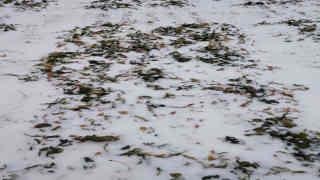In Figure 1, winter canola is pictured in a plot near Manhattan, KS on the morning of February 15, 2021. At the time, overnight low temperatures had fallen below 0°F for four consecutive nights. A low temperature of -18°F was recorded on the night of February 16. Fortunately, the plots experienced nearly 100% survival because the limited snow cover helped insulate them from the bitter cold.

Figure 1. Winter canola nursery under snow cover near Manhattan, KS on the morning of February 15, 2021. Picture by Mike Stamm, K-State Research and Extension.
Factors involved in the “un-hardening” of canola
Ultimately, it may not be the cold temperatures per se that cause winter kill but the rapid fluctuations in temperature, which can be a common occurrence in Kansas during the winter. “Un-hardening” of canola is accelerated when temperatures increase to 60°F or above for an extended period of time (approximately 2 weeks). Un-hardening is a loss of freezing tolerance. However, the effect of fluctuating temperatures and un-hardening during the winter is complex.
Research conducted by K-State indicates winter warming trends can actually have a positive effect on winter survival in some ways. Green leaf tissue may have increased metabolic activity, rejuvenating the overwintering plants. This partly explains why plants growing in the field can survive colder temperatures than plants acclimated at continuous cold temperatures in a controlled environment. If the warming trend is followed by a gradual cool down and no stem elongation occurs, then plants can re-harden. In addition, as long as low nighttime temperatures accompany warmer daytime temperatures, the rate of un-hardening should be slowed.
Winter hardiness traits in canola cultivars
Winter hardiness is an important trait to consider when selecting a cultivar for any cropping system. Differences exist, however, so decisions should be based on results from multiple years and locations. A good rule of thumb to follow is to only select cultivars that show at least 60% or greater survival scores on a consistent basis across site years.
To increase canola’s consistency in the southern Great Plains region, the canola breeding program at K-State continues to select and incorporate winter hardiness traits. Breeding accessions possessing longer vernalization periods are being crossed into the germplasm pool. One theory on improving winter hardiness is that canola can harden more easily after a winter warming trend prior to the vernalization requirement being reached. Therefore, extending the vernalization requirement may allow plants to withstand more variations in temperature during the winter months.
Two important phenotypic defenses against winterkill are a flat, prostrate growth habit, which keeps the crown protected at the soil surface, and the ability to avoid fall stem elongation. The K-State breeding program continues to select for both winter protecting traits among its breeding materials. Another beneficial trait could be the semi-dwarfing growth habit. The crowns of semi-dwarf hybrids are thicker, more compact (shorter internodes), and held closer to the soil surface. The breeding program continues to evaluate the semi-dwarfing trait for potential usefulness in future hybrids.
New research insights on winter survival
A recent review conducted by a team of researchers from K-State (Dr. M. Secchi, former PhD student; M. Stamm; and Dr. Ciampitti) in collaboration with other industry partners provided new insights on the role of environmental variables on winter canola survival. The main objective of this study was to improve our understanding of the impact of meteorological factors on survival of winter canola, in addition to providing an assessment of the risks for winter kill. Research data was obtained from the National Winter Canola Variety Trial from 2003 until 2018 (190 site-years) and auxiliary meteorological data over the last 40 years. Key findings of this study are summarized below.
- Environment was the main factor explaining the variation in winter survival, accounting for 71% of the variation on this variable. Overall winter survival averaged 84%, but a large range of variation across all site-years was present.
- The main meteorological variables explaining mean winter survival were the number of days with temperatures between 14°F and 5°F, the number of cycles when temperatures fluctuated above or below 32°F, and wind chill temperature during the cold period (i.e. the time between the first and last date when average daily temperature reaches 32°F).
- Lastly, variety selection is a key factor for improving the probabilities of obtaining better winter survival. Most of the current varieties and hybrids available fall into either the semi-tolerant or semi-susceptible characterizations, indicating there is room to improve winter survival traits in winter canola.
This information will be valuable in assessing new growing environments for winter canola and will aid breeding programs in evaluating the impact of environment on selection for this trait. Click here to read the full article.
Assessing winter canola stands
After average daily temperatures warm to approximately 40°F, producers can begin evaluating their stands for winter kill. When evaluating winter survival, look for green leaf tissue at the center of the rosette. If green leaf tissue is present and the crown (stem) is firm when squeezed, it is likely the crop will resume active growth as temperatures rise and day length increases. The root may be examined as well for firmness and vigor. If temperatures warm for several days and the crowns remain limp and fleshy, this could be indication that cold temperature damage has occurred. Remember that the crop can sustain some winter stand loss and still produce an acceptable yield as long as the losses are evenly distributed across the field. Normally, a final winter survival assessment can be made after the danger of further stand loss has passed, which is usually mid-March to early-April in Kansas. As long as the center crown and root remain green and firm, the crop has the potential to recover.
Source : ksu.edu